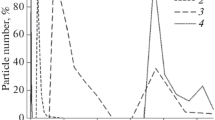Abstract
Composite membranes based on nylon and cellulose acetate (CA) are synthesized by immersing a microporous nylon substrate into a 3% CA solution in acetone. The CA content in the membrane is 12–53% depending on the number of deposited surface layers. The results of studying the properties of the composite membranes show that the water uptake and total porosity of the membranes decrease with an increase in the number of CA layers; this finding is attributed to the compaction of the membrane structure. In addition, it is revealed that the contact angle of the membrane increases by 6.4°; this means that the hydrophilic properties of the membrane decrease. The deposition of the surface layer of CA leads to the smoothing of the porous and rough surface of the nylon membrane base and a decrease in the porosity. Tests on household wastewater treatment using a nylon–CA3 composite nanofiltration membrane are conducted. It is found that the specific flux of the nylon–CA3 membrane with respect to wastewater is 39.7 dm3/(m2 h) at a pressure of 0.7 MPa. According to the results of the study, it is determined that the average degree of purification using the nylon–CA3 membrane is 64.5%. The nylon–CA3 membrane exhibits a high selectivity for multivalent ions (70%) and a high degree of purification in terms of COD and BOD5 (~92%), which is not inferior to the characteristics of a commercial nanofiltration membrane.




Similar content being viewed by others
REFERENCES
A. M. Petrov and I. V. Knyazev, Ross. Zh. Prikl. Ekol. 4, 62 (2018).
A. V. Rodenko, Vest. Brest. Gos. Tekh. Univ. 2, 77 (2016).
G. M. Tardi, V. Bakosh, and A. Iobbagi, Ochistka Stochnykh Vod, 4, 53 (2018).
I. Yu. Shlekova and A. I. Knysh, Ekol. Prom. Rossii 22, 20 (2018).
D. D. Fazullin, G. V. Mavrin, I. G. Shaikhiev, and I. R. Nizameev, Pet. Chem. 58, 145 (2018).
Yu. A. Karavanova, D. V. Golubenko, and A. B. Yaroslavtsev, Membr. Membr. Technol. 2, 251 (2020).
E. Yu. Safronova and A. B. Yaroslavtsev, Petr. Chem. 56, 281 (2016).
D. D. Fazullin, G. V. Mavrin, I. G. Shaikhiev, and E. A. Haritonova, Petr. Chem. 56, 454 (2016).
D. D. Fazullin, G. V. Mavrin, and A. N. Salakhova, Memb. Membr. Technol. 2, 115 (2020).
I. G. Shaikhiev, V. O. Dryakhlov, and D. D. Fazullin, Chern. Met. 7, 46 (2020).
S. Hube, J. Wang, and L. N. Sim, Sep. Purif. Technol. 259, 118125 (2021).
L. Rocha, A. Yuri, P. B. Moser, and V. Moreira, Chem. Eng. J. 406, 104451 (2021).
Y. Wu, R. Yao, and X. Zhang, J. Environ. Chem. Eng. 9, 105164 (2021).
M. Hezarjaribi, G. Bakeri, M. Sillanpaa, M. J. Chaichi, S. Akbari, and A. Rahimpour, J. Environ. Manage. 284, 111996 (2021).
D. D. Fazullin and G. V. Mavrin, Surf. Eng. Appl. Electrochem. 56, 517 (2020).
D. D. Fazullin, L. I. Fazullina, G. V. Mavrin, I. G. Shaikhiev, and V. O. Dryakhlov, Inorg. Mat. Appl. Res. 2, 32 (2021).
A. O. Volkov, D. V. Golubenko, and A. B. Yaroslavtsev, Sep. Purif. Technol. 254, 117562 (2021).
A. D. Alvarenga and D. S. Correa, J. Clean. Prod. 285, 125376 (2021).
X. Pei, G. Lan, Z. Tang, et al., J. Hazard. Mater. 406, 124746 (2021).
Author information
Authors and Affiliations
Corresponding author
Additional information
Translated by M. Timoshinina
Rights and permissions
About this article
Cite this article
Fazullin, D.D., Mavrin, G.V., Dryakhlov, V.O. et al. Parameters of Household Wastewater Treatment Using Composite Membranes with a Surface Layer of Cellulose Acetate. Membr. Membr. Technol. 3, 419–425 (2021). https://doi.org/10.1134/S2517751621060032
Received:
Revised:
Accepted:
Published:
Issue Date:
DOI: https://doi.org/10.1134/S2517751621060032




